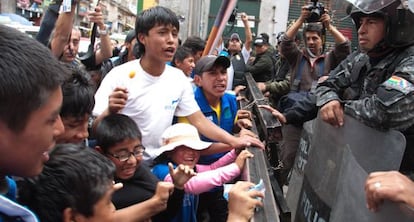Today’s child workers; tomorrow’s poor
Latin American countries are locked in debate over regulation or abolition of practice


Two months ago, Bolivian children took the world by surprise when they protested a bill to prevent child labor. After their demonstrations were violently put down by police in La Paz, President Evo Morales agreed to meet with their representatives, and subsequently he, too, supported pulling the plug on the Childhood and Adolescence Code. This draft legislation had aimed to ensure minors’ right to education and health services, and included a controversial clause about children under 14 being barred from gainful employment.
Since then, the project has been debated by a committee of the Plurinational Legislative Assembly that includes children as well as politicians. Bolivian deputies are in a tight spot, since they now face the challenge of reconciling working children’s desire to keep their jobs with the treaties of the International Labor Organization (ILO) and the UN Convention on the Rights of the Child. The ILO establishes that kids under 15 cannot work, because doing so “generates a circle of poverty and exploitation.”
The issue of child labor, while brought to the fore in Bolivia, resurfaces in varying degrees of intensity all across Latin America. Around 12.5 million children, representing 8.8 percent of the total child population on the continent, hold some kind of job according to the ILO. Of these, 9.6 million do dangerous work — defined as work carried out in hazardous or unhealthy conditions that could result in death, injury or illness.
“The latest global report from October, at the III Global Conference on Child Labor, talks about 168 million child workers in the world,” explains Guillermo Dema, an ILO expert on child labor for Latin America and the Caribbean. “In Asia there are 77.7 million, a 9.3-percent rate, and in sub-Saharan Africa the rate is 21.4 percent. In Europe and in countries with mid-to-high or high incomes, the rate is lower. The number-one factor in child labor is economic in nature, but there are also other causes such as culture; in some places work is part of the family organization.”
Latin American child labor figures are below the global average, and recent years have witnessed a significant decline from 20 million in 2000 to the 12.5 million mentioned in the latest report, adds Dema.
Latin American governments have ratified ILO conventions banning the worst forms of child labor and regulating the minimum age of admission to employment, which is typically 15. Mexico still has not ratified the latter convention because it would entail changing the Constitution, which already states that minors under 14 cannot be employed.
The movement does not defend child labor; it defends working children”
“All the 14-year-olds would be in limbo,” explains Uriel Cabello, an official at Save the Children Mexico. “They would not be recognized as workers, pushing them into a state of irregularity, since they would not stop working.”
The historical center of Mexico City fills up every afternoon with young street vendors trying to find buyers for their candy, peanuts and pencils, which they lug around in boxes that are often too big for them. Aldo Gallegos, coordinator of the project Save the Children in the city center, explains that this informal commerce is one of the main activities that help support families that move here from the countryside.
“We see 1,800 children through the program. Around 60 percent of them work on the family stand or for someone else at a store. Our job focuses on preventing violence within the family: we identify at-risk cases, channel them through a psychologist and do follow-up work. We also organize workshops with parents to discuss children’s rights,” he says.
The work carried out by Save the Children fills a gap left by public institutions. “Mexico City has neither the personnel nor the infrastructure to deal with this problem. Despite the capital’s international image of development, we see backward situations in the very heart of the city, behind the National Palace: up to 15 people living in 12-square-meter rooms. These are hotbeds of small-time drug dealing and prostitution.”
Guillermo Dema, the ILO specialist, notes that the controversy over child labor is nothing new. “It’s part of the history of humanity. Just look at what happened in industrialized nations in the 19th century,” he says.
The Latin American and Caribbean Movement of Working Children and Teenagers (MOLACNATS) represents 8,000 minors from nine countries. Peru, Paraguay, Colombia and Bolivia were the founding nations, but over the last decade Argentina, Chile, Guatemala, Nicaragua and Venezuela have joined. Union leaders believe that age should not be the criterion of choice to regulate access to employment.
“Legislation or prohibition based on age does not resolve the problem, but simply makes a large part of the working population effectively invisible,” says Ángel González, a contributor to MOLACNATS since 2011. “No policy, not even eradication, can be implemented without first listening to the children. The movement does not defend child labor; it defends working children.”
González considers that all of Central America is quite tough when it comes to banning child labor. Venezuela has one of the lowest rates in the region, although growing numbers of 10-to-15-year-olds neither work nor study, according to Unicef data. On the night that Hugo Chávez was first elected president, December 6, 1998, he promised to strip himself of his own name if by the following year any of those kids were still beggars. Of course this promise was never kept, but the government did work hard on lowering that indicator.
Let’s not forget that poverty is one of the leading causes of child labor”
The statistics in Argentina follow the same lines. A 2004 study found that 6.6 percent of minors under 16 had a job; in 2012, after several years of economic growth, that figure was down to 2.2 percent. The man who was labor minister for nearly 11 years under the Kirchner governments, Carlos Tomada, attributes this drop to a reduction in the jobless rate, action against the underground economy and a monthly stipend of 57 euros for unemployed parents who send their children to school and take them in for regular medical checkups.
The strategies against child labor are diverse. The Colombian government has developed a smartphone application in partnership with the private sector called Aquí estoy (Here I am). This app lets users report cases of child labor they are witness to. This system has already generated over 5,000 alerts. The latest child worker figures in Colombia talk about 1.1 million, or 9.8 percent.
In Peru, this rate rises to 23.4 percent, according to the National Statistics Institute. Many children work in illegal mining and as drug mules, but these kids generally don’t show up in the statistics. Meanwhile, Ecuador boasts of being the first Latin American country to eradicate child labor in garbage dumps, in 2011.
Karin Van Wijk, coordinator general for the Costa Rica support group Defensa de los Derechos de los Niños y Niñas Internacional, notes that the rate also went down significantly in this country, but that “experts take these figures with a pinch of salt, and note that there is a lot of invisibility.”
The latest ILO report counted 219,000 working children in Chile, or 5.8 percent of the population. The situation is worse in Brazil, where over a million 10-to-14-year-olds perform some kind of work. Government action against it has not been very successful, either: in the last 10 years, the rate fell slightly from 6.6 percent to 6.2 percent.
Dema mentions several challenges up ahead in the fight against child labor: eradicating social inequality, investing in quality education, and developing inclusive social policies. “Let’s not forget that poverty is one of the leading causes of child labor, but also one of its consequences: it perpetuates the circle,” he says. “Today’s child workers are tomorrow’s poor.”
With reporting by Mabel Azcui, Alfredo Meza, Rocío Montes, Álvaro Murillo, Jacqueline Fowks, Elizabeth Reyes, Soraya Constante and Alejandro Rebossio
Tu suscripción se está usando en otro dispositivo
¿Quieres añadir otro usuario a tu suscripción?
Si continúas leyendo en este dispositivo, no se podrá leer en el otro.
FlechaTu suscripción se está usando en otro dispositivo y solo puedes acceder a EL PAÍS desde un dispositivo a la vez.
Si quieres compartir tu cuenta, cambia tu suscripción a la modalidad Premium, así podrás añadir otro usuario. Cada uno accederá con su propia cuenta de email, lo que os permitirá personalizar vuestra experiencia en EL PAÍS.
¿Tienes una suscripción de empresa? Accede aquí para contratar más cuentas.
En el caso de no saber quién está usando tu cuenta, te recomendamos cambiar tu contraseña aquí.
Si decides continuar compartiendo tu cuenta, este mensaje se mostrará en tu dispositivo y en el de la otra persona que está usando tu cuenta de forma indefinida, afectando a tu experiencia de lectura. Puedes consultar aquí los términos y condiciones de la suscripción digital.
Últimas noticias
Maduro pleads not guilty before the federal court in New York: ‘I am still the president of Venezuela’
A new test can detect Alzheimer’s from a finger prick
UN team enters Sudanese city of El Fasher after paramilitary massacre: ‘It’s like a ghost town’
A recipe for resistance: Indigenous peoples politicize their struggles from the kitchen
Most viewed
- Gilles Lipovetsky: ‘If you want to live better and fall in love, take Prozac, don’t look to philosophy’
- Alain Aspect, Nobel laureate in physics: ‘Einstein was so smart that he would have had to recognize quantum entanglement’
- Alvin Hellerstein, a 92-year-old judge appointed by Bill Clinton, to preside over Maduro’s trial in New York
- Why oil has been at the center of Venezuela-US conflicts for decades
- Cuba confirms death of 32 of its citizens in the US attack against Venezuela








































